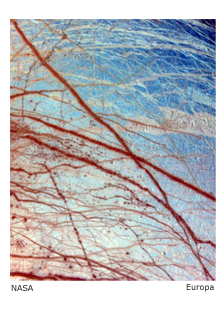|
|
| AST 309L · Search for Extraterrestrial Life |
 1
2
3
4
5
1
2
3
4
5

|
At one level, the subject of extraterrestrial life can be discussed in terms having to do with the physical and biological sciences.
For example, the question of which stars are most likely to have planets bearing life will involve discussions of the origin of planetary
systems, current searches for planets around other stars, and theories and evidence related to the origin of life on earth.
Questions concerning how we should "listen" for alien signals involve consideration of light propagation, spectral lines [just barely: don't
let this frighten you], and sources of interference.
Whether or not you think creatures even remotely like us will develop elsewhere
depends on your view of terrestrial biological evolution, so we will discuss current points of view on that subject.  As we proceed into
the course, the subject matter will gradually shift away from the physical sciences as we inquire into the nature of biological evolution,
"intelligence", language, culture, cognition, and how they might differ (or not exist, or be replaced by alternative concepts) in
extraterrestrial life forms. The possibility of machine intelligence and its future, and recent theories about the nature of consciousness,
may also be reviewed critically if time permits. As we proceed into
the course, the subject matter will gradually shift away from the physical sciences as we inquire into the nature of biological evolution,
"intelligence", language, culture, cognition, and how they might differ (or not exist, or be replaced by alternative concepts) in
extraterrestrial life forms. The possibility of machine intelligence and its future, and recent theories about the nature of consciousness,
may also be reviewed critically if time permits.
However most of the course will be devoted to the areas of the study of extraterrestrial planets and theories and experiments concerning the
origin and evolution of life here and elsewhere. That is most of the subject of "astrobiology" or "exobiology." This subject has experienced
a huge resurgence of scientific interest in the past several years due to several factors. These factors include the discovery of a large
number of planets around other stars, the realization that we may be able to detect Earth-like planets in the near-future, the possible
evidence for biological traces in the "Martian meteorites," and the advent of space missions that will directly explore possible life abodes
in our solar system (e.g. a Europa probe). Astrobiology has finally become a legitimate field of science, with its own institutes, funding
programs, and even universities that offer advanced degrees in the subject. Other aspects of the problem, like "listening" for signals or
signs of extraterrestrial technological civilizations ("SETI" programs) and even potential designs for star travel vehicles are also under study,
so we will devote a significant fraction of time to these topics.
The material will almost entirely be non-mathematical, concentrating on a number of key ideas that can be understood without math.
There is also a fairly large vocabulary of terminology with which you should become comfortable - this should help a lot in studying for
and taking exams.
AST309L: SCHEDULE OF TOPICS, READINGS, AND EXAM DATES
I will list topics according to the organization of the textbook (e.g. 5.2 means section 5.2 in Bennet et al.'s book).
Although I like the clarity and production of our textbook, I decided to alter the order in which we will read its
various sections. That makes it very important for you to make a copy of this reading list and keep it handy.
I will divide the course into five sections, with an exam after each section. The exam dates are only a little tentative,
and time constraints may cause one or more of them to shift by one class day. I will give you plenty of advance warning if such
a change is coming, and will try to avoid it.
|
|
|
|

 As we proceed into
the course, the subject matter will gradually shift away from the physical sciences as we inquire into the nature of biological evolution,
"intelligence", language, culture, cognition, and how they might differ (or not exist, or be replaced by alternative concepts) in
extraterrestrial life forms. The possibility of machine intelligence and its future, and recent theories about the nature of consciousness,
may also be reviewed critically if time permits.
As we proceed into
the course, the subject matter will gradually shift away from the physical sciences as we inquire into the nature of biological evolution,
"intelligence", language, culture, cognition, and how they might differ (or not exist, or be replaced by alternative concepts) in
extraterrestrial life forms. The possibility of machine intelligence and its future, and recent theories about the nature of consciousness,
may also be reviewed critically if time permits.